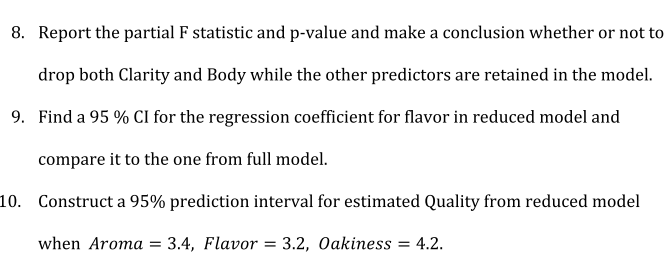Question
Use R programming to answer following questions. Submit related R codes and outputs. Explain the results in your own words to answer each problem. The
Use R programming to answer following questions. Submit related R codes and outputs. Explain the results in your own words to answer each problem. The quality of Pinot Noir wine is thought to be related to the properties of clarity, aroma, body, flavor, and oakiness. Data for 38 wines are given in winequality.txt. Use read.csv("winequality.txt", sep="") to import the data.
"Clarity" "Aroma" "Body" "Flavor" "Oakiness" "Quality" "1" 1 3.3 2.8 3.1 4.1 9.8 "2" 1 4.4 4.9 3.5 3.9 12.6 "3" 1 3.9 5.3 4.8 4.7 11.9 "4" 1 3.9 2.6 3.1 3.6 11.1 "5" 1 5.6 5.1 5.5 5.1 13.3 "6" 1 4.6 4.7 5 4.1 12.8 "7" 1 4.8 4.8 4.8 3.3 12.8 "8" 1 5.3 4.5 4.3 5.2 12 "9" 1 4.3 4.3 3.9 2.9 13.6 "10" 1 4.3 3.9 4.7 3.9 13.9 "11" 1 5.1 4.3 4.5 3.6 14.4 "12" 0.5 3.3 5.4 4.3 3.6 12.3 "13" 0.8 5.9 5.7 7 4.1 16.1 "14" 0.7 7.7 6.6 6.7 3.7 16.1 "15" 1 7.1 4.4 5.8 4.1 15.5 "16" 0.9 5.5 5.6 5.6 4.4 15.5 "17" 1 6.3 5.4 4.8 4.6 13.8 "18" 1 5 5.5 5.5 4.1 13.8 "19" 1 4.6 4.1 4.3 3.1 11.3 "20" 0.9 3.4 5 3.4 3.4 7.9 "21" 0.9 6.4 5.4 6.6 4.8 15.1 "22" 1 5.5 5.3 5.3 3.8 13.5 "23" 0.7 4.7 4.1 5 3.7 10.8 "24" 0.7 4.1 4 4.1 4 9.5 "25" 1 6 5.4 5.7 4.7 12.7 "26" 1 4.3 4.6 4.7 4.9 11.6 "27" 1 3.9 4 5.1 5.1 11.7 "28" 1 5.1 4.9 5 5.1 11.9 "29" 1 3.9 4.4 5 4.4 10.8 "30" 1 4.5 3.7 2.9 3.9 8.5 "31" 1 5.2 4.3 5 6 10.7 "32" 0.8 4.2 3.8 3 4.7 9.1 "33" 1 3.3 3.5 4.3 4.5 12.1 "34" 1 6.8 5 6 5.2 14.9 "35" 0.8 5 5.7 5.5 4.8 13.5 "36" 0.8 3.5 4.7 4.2 3.3 12.2 "37" 0.8 4.3 5.5 3.5 5.8 10.3 "38" 0.8 5.2 4.8 5.7 3.5 13.2
Answers so far for reference:

R codes and output:
> d=read.table('data.txt',header=T,sep='')
> head(d)
Clarity Aroma Body Flavor Oakiness Quality
1 1 3.3 2.8 3.1 4.1 9.8
2 1 4.4 4.9 3.5 3.9 12.6
3 1 3.9 5.3 4.8 4.7 11.9
4 1 3.9 2.6 3.1 3.6 11.1
5 1 5.6 5.1 5.5 5.1 13.3
6 1 4.6 4.7 5.0 4.1 12.8
> attach(d)
The following objects are masked from d (pos = 3):
Aroma, Body, Clarity, Flavor, Oakiness, Quality
> fit=lm(Quality~Clarity +Aroma + Body+ Flavor+ Oakiness )
> summary(fit)
Call:
lm(formula = Quality ~ Clarity + Aroma + Body + Flavor + Oakiness)
Residuals:
Min 1Q Median 3Q Max
-2.85552 -0.57448 -0.07092 0.67275 1.68093
Coefficients:
Estimate Std. Error t value Pr(>|t|)
(Intercept) 3.9969 2.2318 1.791 0.082775 .
Clarity 2.3395 1.7348 1.349 0.186958
Aroma 0.4826 0.2724 1.771 0.086058 .
Body 0.2732 0.3326 0.821 0.417503
Flavor 1.1683 0.3045 3.837 0.000552 ***
Oakiness -0.6840 0.2712 -2.522 0.016833 *
---
Signif. codes: 0 *** 0.001 ** 0.01 * 0.05 . 0.1 1
Residual standard error: 1.163 on 32 degrees of freedom
Multiple R-squared: 0.7206, Adjusted R-squared: 0.6769
F-statistic: 16.51 on 5 and 32 DF, p-value: 4.703e-08
> confint(fit,level=0.95)
2.5 % 97.5 %
(Intercept) -0.54910206 8.5428317
Clarity -1.19427368 5.8731807
Aroma -0.07240642 1.0375075
Body -0.40424262 0.9505650
Flavor 0.54811681 1.7885307
Oakiness -1.23641174 -0.1316086
> model=lm(Quality~Aroma + Flavor+ Oakiness )
> summary(model)
Call:
lm(formula = Quality ~ Aroma + Flavor + Oakiness)
Residuals:
Min 1Q Median 3Q Max
-2.5707 -0.6256 0.1521 0.6467 1.7741
Coefficients:
Estimate Std. Error t value Pr(>|t|)
(Intercept) 6.4672 1.3328 4.852 2.67e-05 ***
Aroma 0.5801 0.2622 2.213 0.033740 *
Flavor 1.1997 0.2749 4.364 0.000113 ***
Oakiness -0.6023 0.2644 -2.278 0.029127 *
---
Signif. codes: 0 *** 0.001 ** 0.01 * 0.05 . 0.1 1
Residual standard error: 1.161 on 34 degrees of freedom
Multiple R-squared: 0.7038, Adjusted R-squared: 0.6776
F-statistic: 26.92 on 3 and 34 DF, p-value: 4.203e-09
Q.4
Summary of the model:
Estimate Std. Error t value Pr(>|t|)
(Intercept) 3.9969 2.2318 1.791 0.082775 .
Clarity 2.3395 1.7348 1.349 0.186958
Aroma 0.4826 0.2724 1.771 0.086058 .
Body 0.2732 0.3326 0.821 0.417503
Flavor 1.1683 0.3045 3.837 0.000552 ***
Oakiness -0.6840 0.2712 -2.522 0.016833 *
Signif. codes: 0 *** 0.001 ** 0.01 * 0.05 . 0.1 1
Residual standard error: 1.163 on 32 degrees of freedom
Multiple R-squared: 0.7206, Adjusted R-squared: 0.6769
F-statistic: 16.51 on 5 and 32 DF, p-value: 4.703e-08
From t test we see that only the variable flavor and oakiness are significant at 5% level of significance.
Since their p-values are less than 0.05
Q.5
Coeffcient of determination = r2 = 0.7206
It means 72.06% of variation in wine quality is explained by the fitted model.
adjusted r2 = 0.6769
Q.6
95% confidence interval for regression coefficient for flavor is ( 0.54811681 , 1.7885307 )
Q.7
Equation for reduced model,
quality = 6.4672 + 0.5801 Aroma + 1.1997 flavor - 0.6023 oakiness

Step by Step Solution
There are 3 Steps involved in it
Step: 1

Get Instant Access to Expert-Tailored Solutions
See step-by-step solutions with expert insights and AI powered tools for academic success
Step: 2

Step: 3

Ace Your Homework with AI
Get the answers you need in no time with our AI-driven, step-by-step assistance
Get Started


